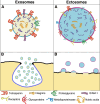Four distinct cytoplasmic structures generate and release specific vesicles, thus opening the way to intercellular communication
- PMID: 39698300
- PMCID: PMC11648438
- DOI: 10.20517/evcna.2023.03
Four distinct cytoplasmic structures generate and release specific vesicles, thus opening the way to intercellular communication
Abstract
In all cells, generation and release of specific vesicles are the initial steps of back-and-forth intercellular communication. These processes are critical in normal physiology and pathophysiology. Vesicles have particular functions appropriate to their targets. When stimulated, they are released into the extracellular space. Four cytoplasmic membrane-bound structures generate their particular vesicles. Among these structures, multivesicular bodies (MVBs) can accumulate many small vesicles in their lumen; release occurs upon MVB exocytosis. Ectosomes are larger vesicles characterized by their responses and are generated directly and released independently from specific microdomains pre-established in the thickness of the plasma membrane. Most lysosomes do not generate vesicles. However, unique components of a minor form, the endo-lysosome, constitute the third class of structures that release a few vesicles by exocytosis with molecules and structures inducing changes in the extracellular environment. The autophagosome, the fourth structure, releases several heterogeneous vesicles by exocytosis with malformed bio-molecules, assembled structures, and damaged organelles. Interestingly, the frequent interaction of autophagosomes with MVBs and their exosomes contributes to the regulation and intensity of their action. The specificity and function of released vesicles depend on their membranes' and luminal cargoes' composition and dynamics. An ongoing investigation of the various vesicles reveals new properties regarding their generation, release, and resulting extracellular processes. The growth of information about structures and their vesicles progressively extends the knowledge base regarding cell communication and contributes to their clinical applications.
Keywords: Autophagosomes; cargo; ectosomes and exosomes; endo-lysosomes; endocytosis; exocytosis; extracellular vesicles (EVs); lysosome storage disorders (LSDs); membrane fusions; microdomains; multivesicular bodies (MVBs); unconventional protein secretion (UPS).
© The Author(s) 2023.
Conflict of interest statement
Authors declared that there are no conflicts of interest.
Figures


Similar articles
-
Exosomes and Ectosomes in Intercellular Communication.Curr Biol. 2018 Apr 23;28(8):R435-R444. doi: 10.1016/j.cub.2018.01.059. Curr Biol. 2018. PMID: 29689228 Review.
-
Ectosomes and exosomes: shedding the confusion between extracellular vesicles.Trends Cell Biol. 2015 Jun;25(6):364-72. doi: 10.1016/j.tcb.2015.01.004. Epub 2015 Feb 12. Trends Cell Biol. 2015. PMID: 25683921 Review.
-
Unconventional Protein Secretion Dependent on Two Extracellular Vesicles: Exosomes and Ectosomes.Front Cell Dev Biol. 2022 Jun 9;10:877344. doi: 10.3389/fcell.2022.877344. eCollection 2022. Front Cell Dev Biol. 2022. PMID: 35756998 Free PMC article. Review.
-
Binding and Fusion of Extracellular Vesicles to the Plasma Membrane of Their Cell Targets.Int J Mol Sci. 2016 Aug 9;17(8):1296. doi: 10.3390/ijms17081296. Int J Mol Sci. 2016. PMID: 27517914 Free PMC article. Review.
-
Do plant cells secrete exosomes derived from multivesicular bodies?Plant Signal Behav. 2007 Jan;2(1):4-7. doi: 10.4161/psb.2.1.3596. Plant Signal Behav. 2007. PMID: 19704795 Free PMC article.
Cited by
-
Basic helix-loop-helix ARNT like 1 regulates the function of immune cells and participates in the development of immune-related diseases.Burns Trauma. 2025 Jan 18;13:tkae075. doi: 10.1093/burnst/tkae075. eCollection 2025. Burns Trauma. 2025. PMID: 39830193 Free PMC article. Review.
-
MSC-sEVs exacerbate senescence by transferring bisecting GlcNAcylated GPNMB.Stem Cell Res Ther. 2025 Jan 23;16(1):23. doi: 10.1186/s13287-025-04140-9. Stem Cell Res Ther. 2025. PMID: 39849576 Free PMC article.
-
An Injectable Hydrogel Bioimplant Loaded with Engineered Exosomes and Triple Anti-Tuberculosis Drugs with Potential for Treating Bone and Joint Tuberculosis.Int J Nanomedicine. 2025 Jan 31;20:1285-1302. doi: 10.2147/IJN.S480288. eCollection 2025. Int J Nanomedicine. 2025. PMID: 39911262 Free PMC article.
-
Mitochondria transfer for myelin repair.J Cereb Blood Flow Metab. 2025 Mar 13:271678X251325805. doi: 10.1177/0271678X251325805. Online ahead of print. J Cereb Blood Flow Metab. 2025. PMID: 40079508 Free PMC article. Review.
References
-
- Johnstone RM, Adam M, Hammond JR, Orr L, Turbide C. Vesicle formation during reticulocyte maturation. Association of plasma membrane activities with Johnston RM released vesicles (exosomes) J Biol Chem. 1987;262:9412–20. - PubMed
-
- Heijenen HF, Schlel AE, Fijnheer R, Geuze HJ, Sixma JJ. Activated platelets release two types of membrane vesicles: microvesicles by surface shedding and exosomes derived from exocytosis of multivesicular bodies and a-granules. Blood. 1999;94:3791–9. - PubMed
Publication types
LinkOut - more resources
Full Text Sources
